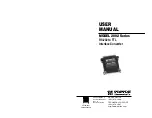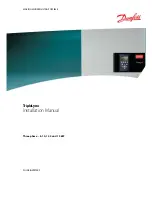
INSTALLATION & SET-UP
8
3 . 1. 2 Crypto Resynch
Bit-switch ON: The Crypto Resynch function is DISABLED
Bit-switch OFF: The Crypto Resynch function is ENABLED. when the LV2000 detects a loss
of synch on the receive data, it will pulse the RS control signal for half a second and then
wait for 5 seconds before checking for synchronisation again.
3 . 1. 3 Resynch Mode
Bit-switch ON: Normal Sate of Resynch control is High (Bit-switch in ON position). Resynch
pulse will be Low (OFF) when ENABLED.
Bit-switch OFF: Normal Sate of Resynch control is Low (Bit-switch in OFF post ion). Resynch
pulse will be High (ON) when ENABLED.
Note:
The above High/Low states refer to the A signal of a differential pair.
3 . 1. 4 Resynch Control
Bit-switch ON: The Resynch control will be differential LVDS.
Bit-switch OFF: The Resynch control will be single ended LVTTL
3 . 1. 5 Data Invert
Bit-switch ON: Normal operation.
Bit-switch OFF: The data is inverted.
3 . 1. 6 Duplex
Bit-switch ON: LAN port operates Half Duplex in manual mode, ignored in Auto-Negotiate
mode.
Bit-switch OFF: LAN port operates Full Duplex in manual mode, ignored in Auto-Negotiate
mode.
3 . 1. 7 Speed
Bit-switch ON: LAN port operates at 10Mbps in manual mode, ignored in Auto-Negotiate
mode.
Bit-switch OFF: LAN port operates 100Mbps in manual mode, ignored in Auto-Negotiate
mode.
3 . 1. 8 Auto Negotiation
Bit-switch ON: LAN port Auto Negotiates for Speed and Duplex.
Bit-switch OFF: LAN port uses manual settings for Speed and Duplex.
Note:
The IEEE802.3 Auto-Negotiation standard allows for operation with ports that support
either Auto-Negotiation or a fixed configuration. Note that when operating with a fixed
configuration port, the Auto negotiation function can ONLY detect the speed of the link. The
fixed link will always be assumed to be half duplex.































